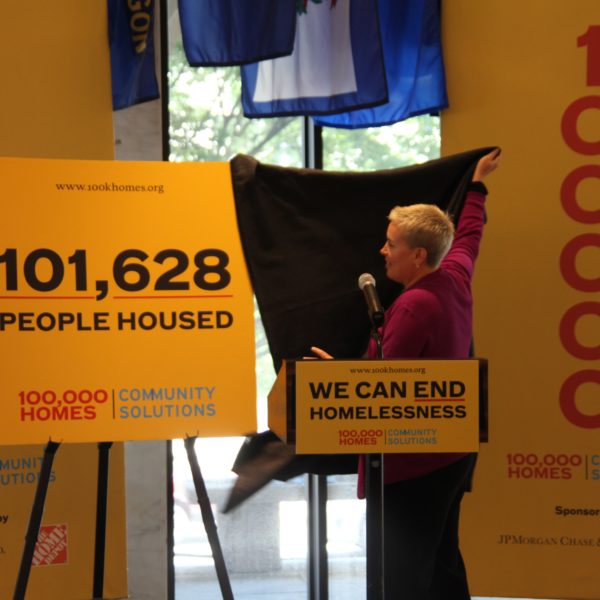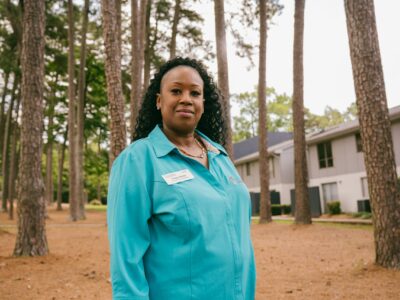Calling the fight to end homelessness “America’s next moonshot,” 100,000 Homes Campaign Director and former Army Captain Becky Kanis announced today that communities participating in the 100,000 Homes Campaign have permanently housed 101,628 homeless Americans, including 31,171 homeless Veterans, one month ahead of their four-year July deadline. That number represents an estimated annual taxpayer savings of $1.3 billion and reflects the collective work of 238 U.S. communities who have joined the Campaign since July 2010. The 100,000 Homes Campaign is a national movement coordinated by New York-based non-profit, Community Solutions, which launched the effort in July of 2010.
Participating communities have helped speed the downward national trend in homelessness by focusing on Veterans, the chronically homeless, and those who face the highest risk of death on the streets. Between 2010 and today, Veteran homelessness has declined by 24 percent to 57,849, with another sizeable decrease expected when new federal data is released this summer. During the same period, the number of individuals experiencing chronic homelessness has dropped by fifteen percent from 109,812 to 92,593.
Kanis was joined by former Army Private First Class Alvin Hill, who battled homelessness for more than twenty years, often sleeping on park benches within view of the Capitol. Sharing his story with those gathered, Hill said it was “a tragedy” that anyone who would put his life on the line for America could return home to sleep on the streets. In April, Hill became the 100,000th person housed when A-SPAN, the local organization leading the 100,000 Homes Campaign in Arlington, VA, helped him escape the streets for a permanent apartment.
“Ending homelessness is America’s next moonshot,” said Kanis, a West Point graduate who commanded special operations units in the Army before setting her sights on homelessness. “Campaign communities have shown that it is possible to end homelessness quickly and permanently, even for people considered the hardest to help. This is an urgent national crisis, and we are out of excuses.”
“By reaching this milestone, the 100,000 Homes Campaign and communities across the country are providing further proof that ending homelessness is possible,” said Laura Zeilinger, Executive Director of the U.S. Interagency Council on Homelessness. “Now is the time to harness the momentum and charge forward with greater urgency, using the evidence-based practices we know work to end homelessness—Housing First, permanent supportive housing, and rapid re-housing. Together, we can ensure everyone has a safe, stable place to call home.”
Ending Homelessness Faster
Communities participating in the Campaign have achieved significant improvement in their housing performance. They have gone from housing an average of 1.6 percent of their chronically homeless populations each month to 5.1 percent. Additionally, 60 of these communities are now on track to end chronic homelessness outright in the next three years. In 2011, that number was just twelve.
Ending Veteran Homelessness
As part of the Campaign, participating communities have partnered with local VA branches and Veterans non-profits to identify previously unknown, chronically homeless Veterans on the streets in need of VA-funded permanent housing. This increased local collaboration has resulted in permanent housing for 31,171 medically vulnerable and chronically homeless Veterans since July 2010. In that time, Veteran homelessness has declined 24 percent, offering a hopeful sign for President Obama’s plan to end Veteran homelessness by the end of 2015.
Rep Tammy Duckworth (IL-8), an Iraq War Veteran and former Assistant VA Secretary, said, “Our Veterans have served the United States with remarkable distinction, and we owe them a profound debt when they return home. The Campaign has helped communities make good on that debt by helping more than 30,000 homeless Veterans escape the streets. Today, we celebrate that progress and we recommit ourselves to ending homelessness for all Veterans. The streets are no place for America’s heroes to call home.”
Phoenix, AZ and Salt Lake City, UT, which recently became the first cities in America to end chronic homelessness among Veterans, are Campaign participants and have coached other communities at Campaign events. Both communities attribute part of their success to their participation in the Campaign.
“Phoenix was one of the first cities to join the 100,000 Homes Campaign,” said Phoenix Mayor Greg Stanton. “The experience and resources we gained were a key piece of the puzzle that helped us end chronic homelessness among Veterans in our city. The Campaign has helped us learn from other cities, and people from Phoenix have served as teachers and coaches to other Campaign communities as well. We’re proud to own our piece of this national milestone on the way to ending homelessness.”
Key funders in the fight to end Veteran homelessness also acknowledged the Campaign’s achievement:
“The fight to end homelessness, especially for our Veterans, will be won or lost at the local level. The 100,000 Homes Campaign has generated a new urgency around ending homeless in our communities, and we have been proud to provide critical financial support from its earliest days,” said Todd Bowers of JPMorgan Chase, which has provided the Campaign with more than $750,000 in funding since 2011.
“The 100,000 Homes Campaign is demonstrative of how the public and private sectors can work together at the national and local level to impact meaningful and necessary change. We’re proud to support the Campaign and the collaborative solutions it continues to inspire as part of our $80 million commitment to help ensure every Veteran has a safe place to call home,” said Gaven Gregory, Executive Director of The Home Depot Foundation.
Dramatic Taxpayer Savings
An analysis developed by Liana Downey and Associates, a strategic government advisory firm, estimates the total taxpayer savings from housing 100,000 chronically homeless Americans at more than $1.3 billion annually, based on a review of existing studies. This is due to the fact that chronically homeless people make frequent use of emergency services like the ER, where a single night’s stay often costs more than a full month’s rent in permanent housing. Connecting these individuals to permanent housing with simple supportive services to help them remain housed reduces public costs by as much as 37 percent each year.
Chronically homeless Americans are defined federally as those who have been homeless for one year or more, or four or more times in the past three years, and are living with a disabling medical condition. This group accounts for 12-15 percent of the homeless population in US communities yet consumes more than 70 percent of all public dollars spent on homelessness through high emergency service usage.
“Study after study confirms that it is cheaper to end homelessness than to let it persist,” said Rosanne Haggerty, President of Community Solutions, which launched and coordinates the Campaign. “Fiscal concerns are no longer an acceptable excuse for failing to end homelessness. Permanent housing with services, targeted to chronically homeless Americans, is the smartest, most cost-effective way to do the right thing.”
Campaign History and Approach
Community Solutions launched the 100,000 Homes Campaign in July of 2010 at the annual conference of the National Alliance to End Homelessness. At that time, just 36 communities had agreed to participate in the national effort to house 100,000 people. Community Solutions also set a deadline for this ambitious goal: July 2014.
Over the life of the Campaign, the number of enrolled communities has grown to 238 in more than 40 states. Together, those communities have attended monthly webinars and regional in-person convenings to share new ideas and problem solve together. They have also made use of social media and a virtual infrastructure to learn together and spur each other on. Participation has been free of charge for all communities, thanks to the Campaign’s generous funders and partners.
The Campaign was patterned after the 100,000 Lives Campaign, a national campaign initiative led by the Institute for Healthcare Improvement, a leading innovator in health and health care improvement worldwide. Launched in 2004 and lasting 18 months, IHI’s campaign engaged over 3,100 U.S. hospitals in implementing evidence-based practices to protect patients from avoidable infections, medication errors, surgical complications, and deaths. Through this work and other efforts, participating hospitals prevented over 122,000 unnecessary deaths and took part in a vast learning network to share best practices and innovative quality improvement strategies. IHI created tools and resources and a mentor registry that continue to help hospitals improve today.
“I congratulate Community Solutions for this historic achievement and am proud of the role IHI played in inspiring a group of committed individuals to adapt our campaign principle of ‘some is not a number, soon is not a time,’” said IHI President and CEO, Maureen Bisognano. “The courageous team from the 100,000 Homes Campaign set an audacious goal with an equally audacious deadline. That they hit their goal, with time to spare, is a testament to careful planning, skillful execution, extraordinary effort, and most importantly to the partnerships they formed in and with communities across the country. The commitment to improving the lives of homeless Americans with permanent housing and surrounding support creates possibility, health, and better futures for many people for the first time. We all need to applaud and learn from this effort.”
Communities participating in the 100,000 Homes Campaign have achieved success by doing four things differently:
- First, they hit the streets at 4 a.m. to identify all of their homeless neighbors by name and build a file on each person’s housing needs.
- Second, they prioritize their most vulnerable and chronically homeless neighbors for the first permanent housing available, without preconditions. This research-based, Housing First approach is proven, even for those who have been homeless for extended periods of time or who face serious health conditions associated with an increased risk of death on the streets.
- Third, they track and measure their monthly housing progress against predetermined benchmarks designed to put them on pace to end chronic and Veteran homelessness on the federal timeline. When the Campaign began, just 12 participating communities were measurably on track to end chronic and veteran homelessness. Today, that number has grown to 60.
- Finally, they use data and process improvement techniques drawn from industry to streamline their local housing systems, making them faster and more easily navigable for the homeless Americans who depend on them. Many communities have reduced the time required to house a single homeless individual from over a year to as little as two weeks.
What’s Next?
The 100,000 Homes Campaign will continue to account for new people housed until a final number is reached at the end of July. Next January, Community Solutions will launch Zero: 2016, a national effort to build on the success of the Campaign by helping communities get to zero on chronic and Veteran homelessness.
###






